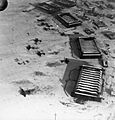No. 77 Squadron RAF facts for kids
Quick facts for kids No. 77 Squadron RAF |
|
|---|---|
| Active | 1 October 1916 - 13 June 1919 14 June 1937 - 1 June 1949 1 September 1958 – 10 July 1963 |
| Country | |
| Branch | |
| Final base | RAF Feltwell |
| Motto(s) | Latin: Esse potius quam videri ("To be, rather than seem") |
| Insignia | |
| Squadron badge heraldry | A thistle. The thistle commemorates the fact that the squadron was formed in Scotland. |
No. 77 Squadron RAF was a special group of the Royal Air Force (RAF). They were active at different times between 1916 and 1963. This squadron played many roles, from flying planes in wars to handling powerful missiles.
Contents
History of No. 77 Squadron
No. 77 Squadron first started on October 1, 1916. This happened in Edinburgh, Scotland. They used B.E.2 and B.E.12 planes. The squadron was closed down on June 13, 1919, at RAF Turnhouse.
Reformation and World War II
The squadron was started again on June 14, 1937. This time, it was at RAF Finningley. They first flew Hawker Audax planes. Later, they got Vickers Wellesley aircraft.
In 1938, the squadron moved to RAF Driffield. Here, they became part of No. 4 Group. They also started using Armstrong Whitworth Whitley planes.
In May 1942, the squadron joined Coastal Command. This meant they helped protect the coast. They flew patrols to find and stop enemy submarines. Their base at this time was RAF Chivenor.
New Aircraft and Roles
In October 1942, the squadron changed planes again. They began flying Halifaxes from RAF Elvington. In May 1944, they moved to RAF Full Sutton.
On May 8, 1945, the squadron joined Transport Command. This new role meant they moved supplies and people. In July 1945, they got Douglas Dakota planes. The squadron moved to Broadwell in August 1945. Then, in October 1945, they went to India.
The squadron was officially closed down on November 1, 1946. Its members became part of No. 31 Squadron.
Post-War Operations
No. 77 Squadron was reformed at Broadwell in December 1946. This happened when No. 271 Squadron was given a new number. The squadron used Dakota planes during the Berlin Airlift. This was a huge effort to fly supplies into Berlin. The squadron was closed down again on June 1, 1949, at RAF Waterbeach.
Strategic Missiles Era
The squadron was started for a third time on September 1, 1958. It was called 77(SM) Sqn. "SM" stood for Strategic Missile. This was part of a plan called Project Emily. The squadron was given three PGM-17 Thor missiles. These were powerful intermediate range ballistic missiles. They were based at RAF Feltwell.
In October 1962, the world faced the Cuban Missile Crisis. During this time, the squadron was ready for action. Their missiles were aimed at important targets in the USSR.
The squadron was closed down for good on July 10, 1963. This happened when the Thor Missile Program in Britain ended.
Aircraft and Missiles Used
- 1916-1918 Royal Aircraft Factory BE2c
- 1916-1918 Royal Aircraft Factory BE12
- 1916 Airco DH.6
- 1916 Royal Aircraft Factory BE2d
- 1917-1918 Royal Aircraft Factory BE2e
- 1917-1918 Royal Aircraft Factory RE8
- 1917-1918 Royal Aircraft Factory BE12b
- 1918-1919 Avro 504K (NF)
- 1937 Hawker Audax
- 1937-1938 Vickers Wellesley
- 1938-1939 Armstrong Whitworth Whitley III
- 1939-1942 Armstrong Whitworth Whitley V
- 1942-1945 Handley Page Halifax II, III, VI and V
- 1945-1946 Douglas Dakota
- 1946-1949 Douglas Dakota
- 1958-1963 PGM-17 Thor IRBM
See also
Images for kids


